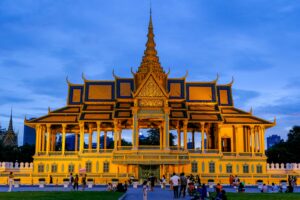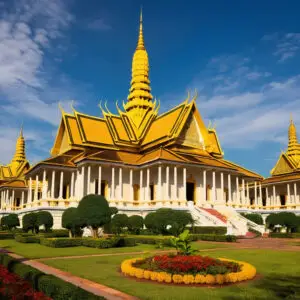The Royal Palace of Phnom Penh, an architectural marvel and a symbol of Cambodian history and culture, is one of the top attractions in the capital city. With its grand pagodas, lush gardens, and intricate design, the Royal Palace offers visitors a glimpse into Cambodia’s royal heritage and is a must-visit site for those seeking a deeper understanding of the country. This guide provides an overview of the palace’s history, key attractions, visitor tips, and everything tourists need to know for an enriching visit.
Overview and History of the Royal Palace
The Royal Palace, known in Khmer as “Preah Barum Reachea Veang Chaktomuk Serei Mongkol,” has been the residence of the Cambodian kings since it was first constructed in 1866 during the reign of King Norodom. The palace complex combines traditional Khmer architecture with influences from French colonial design, creating an impressive and beautiful structure that stands as a testament to Cambodia’s artistic and cultural heritage.
The palace has served as the primary residence of the monarchy, though some sections are closed to the public as they are still in use by the royal family. Over the years, it has undergone renovations and restorations to maintain its splendor and importance as a cultural landmark.

Main Attractions in the Royal Palace Complex
The Royal Palace is a large complex with several notable buildings, temples, and pavilions that showcase the grandeur of Cambodian architecture. Here are the key areas that visitors can explore:
Throne Hall (Preah Tineang Tevea Vinichhay)
The Throne Hall is one of the palace’s most iconic buildings, distinguished by its tall spire topped with a four-faced tower representing Brahma, the Hindu god. It is here that royal ceremonies, such as coronations and religious events, take place. The hall’s interior is adorned with murals, intricate decorations, and a statue of the Buddha. Although visitors cannot enter the Throne Hall, its exterior and the surrounding areas are worth exploring for their architectural detail and historical significance.
Silver Pagoda (Wat Preah Keo Morakot)
Also known as the Silver Pagoda, Wat Preah Keo Morakot is one of the most revered sites within the Royal Palace. Named for its floor, which is inlaid with over 5,000 solid silver tiles, the Silver Pagoda houses many of Cambodia’s most sacred treasures, including the Emerald Buddha (made of Baccarat crystal) and a life-sized gold Buddha statue adorned with diamonds. The pagoda serves as both a religious site and a museum, offering visitors a rare chance to view these national treasures up close.
Moonlight Pavilion (Preah Thineang Chan Chhaya)
The Moonlight Pavilion is a beautifully constructed open-air pavilion used for traditional Khmer dance performances and royal ceremonies. It is located along the palace’s eastern wall, providing views of the Tonle Sap River. Its elegant design, including a tiered roof and ornate detailing, makes it a popular spot for photos and a significant example of Khmer architectural beauty.
Inner Courtyards and Gardens
The palace grounds are beautifully landscaped, with manicured gardens, lush lawns, and a variety of tropical plants and flowers. Visitors can walk through the gardens and inner courtyards to experience the tranquility and beauty that surround the Royal Palace. The gardens feature sculptures, fountains, and shaded areas, offering a peaceful retreat amidst the grandeur of the palace.

Visitor Information and Tips
Location: The Royal Palace is centrally located along Sothearos Boulevard, near the banks of the Tonle Sap River in Phnom Penh.
Opening Hours: The Royal Palace is open daily, typically from 8:00 AM to 10:30 AM and from 2:00 PM to 5:00 PM. Hours may vary on special holidays or during royal events, so it’s advisable to check the schedule beforehand.
Admission Fees: The entrance fee for the Royal Palace is usually around $10 USD for foreign tourists, which includes access to the main palace grounds and the Silver Pagoda.
Dress Code: As the Royal Palace is a revered site, visitors are required to dress respectfully. Shoulders and knees must be covered, so wearing long pants or skirts and modest tops is recommended. If needed, scarves or sarongs can often be rented or bought near the entrance.
Photography: Photography is allowed in the palace gardens and courtyards, but it is restricted inside certain areas, such as the Throne Hall and Silver Pagoda. Respect the signs and staff instructions regarding photography.
Best Time to Visit: The best time to visit the Royal Palace is early in the morning or late afternoon to avoid the midday heat and larger crowds. Visiting during the dry season (November to February) is also recommended, as the weather is cooler and more comfortable.
Nearby Attractions
Phnom Penh’s Royal Palace is located in a central area close to several other major attractions. Here are a few nearby sites worth exploring:
- National Museum of Cambodia: Just a short walk from the Royal Palace, the National Museum houses one of the world’s most comprehensive collections of Khmer art and artifacts. It’s an ideal next stop for those wanting to learn more about Cambodia’s rich history and culture.
- Independence Monument: Located about 15 minutes away by foot, the Independence Monument is a striking structure built to celebrate Cambodia’s independence from French rule. It is especially impressive when lit up at night.
- Riverside Promenade: The Tonle Sap River runs alongside the Royal Palace, and the riverside promenade offers a pleasant place to relax, walk, or enjoy local food. The area comes alive in the evening with street vendors, locals, and visitors.
- Wat Phnom: This hilltop pagoda is one of Phnom Penh’s most important religious sites and is just a short drive from the palace. It offers panoramic views of the city and holds a special place in the hearts of Cambodians.

Interesting Facts about the Royal Palace
French Influence: Though the palace’s design is distinctly Khmer, it was influenced by the French during the colonial period. French architects contributed to the layout, making it a blend of local and European styles.
Historical Events: The palace has witnessed numerous historical events and changes in power, including Cambodia’s transition to independence. Its preservation is a testament to the resilience and cultural pride of the Cambodian people.
Ceremonial Importance: The Royal Palace continues to be a site for important royal and religious ceremonies, underscoring its ongoing role in Cambodian society.
Symbol of National Identity: The palace’s design elements, from the spires to the Naga motifs, symbolize Cambodian beliefs, mythology, and the influence of Buddhism and Hinduism in Khmer culture.
Practical Tips for a Smooth Visit
Stay Hydrated: Phnom Penh’s warm and humid climate can be challenging, so make sure to carry water, especially if you plan to explore the palace grounds for an extended period.
Plan for Enough Time: To fully appreciate the beauty and history of the Royal Palace, plan for at least two hours to explore the main sites and gardens.
Respect Local Customs: The Royal Palace is an active site of worship and a symbol of Cambodian identity. Be mindful of local customs, speak quietly in reverence, and avoid touching religious objects.
Guided Tours: Consider hiring a guide or joining a tour to better understand the significance of each area within the palace complex. Knowledgeable guides can provide fascinating insights and stories about the royal family and Cambodian culture.
Final Thoughts: Experiencing the Majesty of the Royal Palace
Visiting Phnom Penh’s Royal Palace is more than just a tour of Cambodia’s royal architecture; it’s an immersion into the history, artistry, and cultural pride of the nation. From the Silver Pagoda’s sacred treasures to the grandeur of the Throne Hall and the serenity of its gardens, the Royal Palace offers a memorable experience for any traveler to Cambodia. As a symbol of resilience and cultural heritage, the palace not only celebrates Cambodia’s past but also stands as a beacon of its vibrant present and hopeful future.
Whether you’re a history buff, an architecture enthusiast, or a curious traveler, the Royal Palace is a must-see attraction that captures the heart of Cambodian heritage. Don’t miss the chance to explore this remarkable site on your journey through Phnom Penh.
